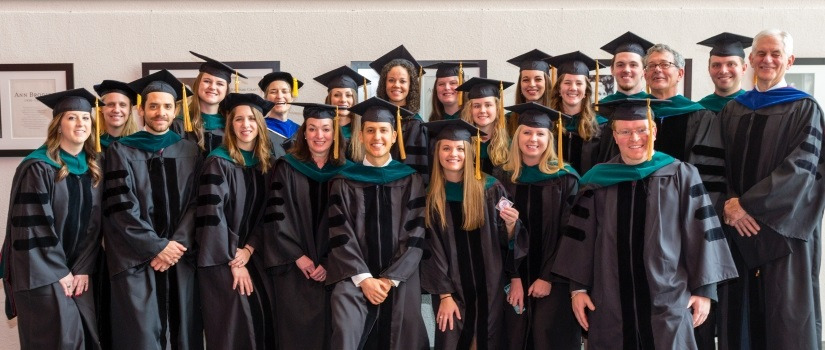March 21, 2018 | Erin Bluvas, bluvase@sc.edu
December 2017 doctor of physical therapy (DPT) graduates who took the national physical therapy exam in December 2017 or January 2018 had a 100 percent first time pass rate compared with a 92.7 percent national average. The average score for the USC class was 732 while the national average was 679.
These scores represent a substantial improvement in the average total scores over the program’s last three graduating classes, which hovered between 677 and 698. UofSC’s 2017 class scored above the national average in all eight of the exam’s categories [see results summary [pdf] for more information on the scores for each category and how USC compared to other schools.]
“The scores clearly indicate that our students have a strong knowledge base to transition into the clinical workforce,” says Stacy Fritz, associate professor of exercise science, which houses the DPT program, and DPT program director. “They also show how our students, on average, are outperforming the students from programs that are ranked in the top 10 in the country on the national licensure exam.”
The national physical therapy exam is one component of the process to become a licensed physical therapist. It is designed to assess graduates’ entry-level competence into the profession. The exam was created by the Federation of State Boards of Physical Therapy to help ensure that only those who have the requisite knowledge of physical therapy are licensed and to help regulatory authorities evaluate candidates and provide comparable standards from jurisdiction to jurisdiction.
Because the nation-wide scores are one of the few elements of physical therapy licensure that are consistent across jurisdictions, they are especially helpful in differentiating among not only candidates but their respective programs as well. When viewed by cohort, performance metrics on this exam reflect both the caliber of the students and their programs.
“I think the scores tell us that we are admitting the right students and training them well,” says Fritz. “We have hardworking, intelligent students who are driven by a dedicated core and adjunct faculty and committed, passionate clinical instructors. I think we do an excellent job of teaching both the clinical reasoning and the hands-on skills necessary in the profession.”
The Arnold School’s DPT program is in the top 16 percent of the 230 physical therapy programs accredited by the Commission on Accreditation in Physical Therapy Education and ranked No. 25 among public institutions (U.S. News & World Report). These achievements are not merely happenstance.
Faculty members designed the program from the ground up to attract the very best students and provide them with personalized education—ever since the first class matriculated in 2001. Their “boutique” approach to teaching a small class size with individualized instruction has garnered the attention of aspiring physical therapists from across the country. They have received over 600 applicants for just 22 spots in their incoming 2018-2019 class.
The UofSC DPT program prepares students to become expert clinicians with 100 percent rates in graduation, ultimate licensure passage, and employment in clinical positions. They provide a diverse array of clinical opportunities through their network of partners and engage students in research studies relevant to various aspects of the field. It’s all part of the program’s goal to bring together outstanding students with excellent faculty and clinicians to advance the profession and the field.
Related:
